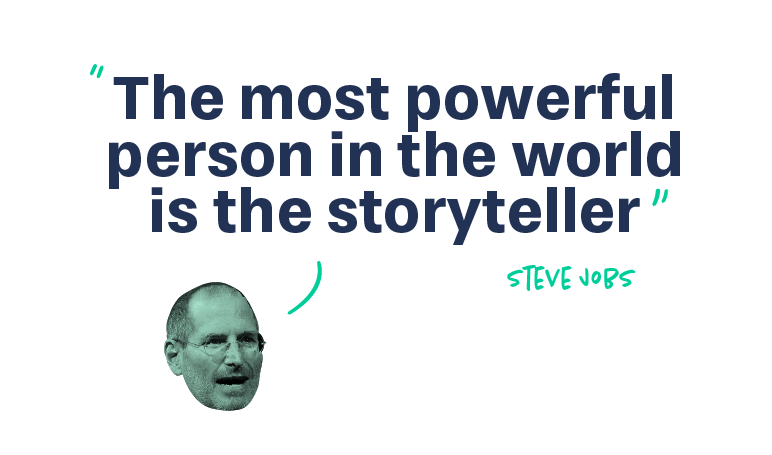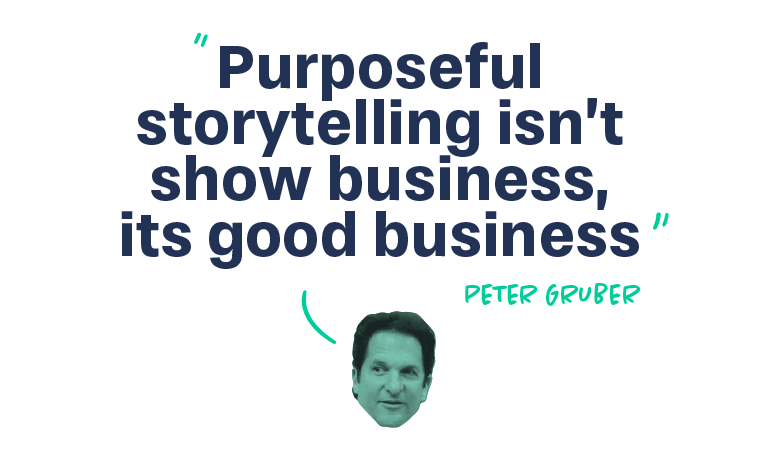Storytelling – the secret weapon to any succesful presentation
How storytelling can transform your presentation from a mere information dump into a memorable and impactful experience.

Storytelling is a potent force, bridging the gap between informing, connecting, and persuading. It’s an ancient art, the cornerstone of human connection, predating written language and evolving through spoken word, books, plays, and film. Research confirms its power: stories captivate, fostering engagement and driving support for innovative ideas in any setting. When audiences are drawn into a narrative, they listen, question, and participate, leading to more impactful outcomes. Furthermore, storytelling builds rapport through empathy and shared experience, quickly dismantling communication barriers and forging connections, even in unfamiliar settings.
This article will explain what storytelling truly means and why storytelling is the most powerful skill you can master to create compelling presentations
This article will dive into why storytelling is the most powerful skill you can master to create compelling presentations, by detailing what it is, why it works, and how to apply it in all aspects of your presentation.

Death by PowerPoint
It is a fairly uncontroversial claim that inspiring and truly engaging presentations are in scarcity in the corporate world. In corporate meeting rooms, fully remote summits, seminars, and the like. “Death by PowerPoint” is really a thing. The term describes the experience of enduring a tedious and ineffective presentation, typically one that heavily relies on PowerPoint slides. It’s characterised by:
Overly text-heavy slides
Slides packed with dense paragraphs of text, often read verbatim by the presenter.
Lack of engagement
Presentations that fail to capture or maintain audience attention, leading to boredom and disinterest.
Poor visual design
Slides with cluttered layouts, distracting animations, or irrelevant graphics.
Presenter dependence on slides
The presenter relies too heavily on the slides, rather than engaging with the audience and providing meaningful explanations.
Monotonous delivery
A dull and uninspiring presentation style that further contributes to audience disengagement.
Essentially, “death by PowerPoint” occurs when the presentation tool becomes a crutch, hindering effective communication rather than enhancing it. It results in a passive and unmemorable experience for the audience.

Storytelling to the rescue
Storytelling is an incredibly effective approach to fixing “death by PowerPoint” because it has the potential to transforms dull, monotonous presentations into memorable and engaging experiences. Storytelling addresses these issues by fundamentally changing the structure and delivery of the content. More than just conveying information, storytelling builds bridges of human connection, persuasion and understanding.
This is our breakdown of how storytelling can an significantly enhance a presentation on multiple levels:
- Enhanced Engagement
Stories capture attention and hold it. They create a sense of anticipation and make the audience want to know what happens next. - Improved Memory and Retention:
People are more likely to remember stories than they are to remember isolated data points. Stories provide context and emotional connection, which helps information stick. - Emotional Connection:
Stories evoke emotions, which can create a deeper connection between the speaker and the audience. This emotional connection can make the message more persuasive and impactful. - Increased Understanding:
Stories can simplify complex concepts and make them easier to understand. By framing information within a narrative, you can provide context and make it more relatable. - Persuasion and Influence:
Stories can be used to illustrate the benefits of a product, service, or idea. By showing how something has helped others, you can persuade the audience to take action.

How to incorporate storytelling
We probably all have a clear idea what storytelling is in movies, music, adversing and other fields of the entertainment industry. But what is storytelling in a business presentation? and how would you incoorporate it?
We believe storytelling should be integrated in every aspect of your presentation.
In a presentation storytelling can be incorporated in numerous ways. It should be considered in everything you do. The visuals you include, the structure of your presentation, the delivery of your message, your body language, or the design of your slides.
You don’t have to do everything at once, obviously. But having awareness of how presentations gives a wide vocabulary of how storytelling can be included is key. So try to consider carefully how each element of your presentation contributes to the narrative.
Storytelling involves using narrative techniques to convey information in a compelling and memorable way. It goes beyond simply presenting facts and figures; it aims to engage the audience on an emotional and intellectual level.
Introduce a problem or challenge that creates tension and keeps the audience engaged. Use language and imagery that evokes emotions and creates a memorable experience.
Storytelling can transform a mundane presentation into a captivating experience. Here are some examples of how to effectively use storytelling in various presentation scenarios:
In the structure
Using storytelling when presenting is about transforming your role from an information provider to a guide, leading your audience on a journey. It’s not just about a single anecdote; it’s about structuring your entire presentation around a narrative that connects with your audience emotionally and intellectually.
Think of your presentation as a story. Presenting an idea within a narrative allows your audience to engage with it. Presentations are no exception.
Create a basic skeleton to help you build a dramatic structure. This structure can vary, depending on your content, your audience, and the setting, of course. But simply by following a classic three-part story structure (beginning, middle, and end), you can create a more engaging message that is easier to digest, remember, and retell.
A coherent narrative should be the backbone of a compelling presentation. While each slide can have a clear individual message, the true power lies in weaving them into a single, compelling story. This will guide your audience and connect disparate points, making your message memorable. Without it, your presentation risks becoming a jumble of facts. A strong narrative arc keeps the audience engaged and invested throughout.

In your visuals
They don’t just decorate the slides; they work hand-in-hand with your words to create an emotional connection, simplify complex ideas, and make your message unforgettable. Instead of being a crutch for the presenter, visuals become a key part of the narrative.
Metaphors are a powerful storytelling tool, and you can make them even more potent with visuals. They help the audience quickly grasp abstract or complex concepts by connecting them to something familiar.
A powerful image can elicit a feeling—joy, sadness, urgency, or hope—in an instant. This emotional connection is far more effective at making a message stick than a dry list of facts.
In your copy writing.
Visuals can create a sense of empathy and relatability. Seeing a photograph of a person in a particular situation allows the audience to put themselves in their shoes and connect with the story on a personal level.
In the narrative
In your delivery
Use basic storytelling techniques in your, that can transform your presentation into an engaging, emotional experience that your audience will remember long after you’ve finished speaking.
We recently did an article on presentation techniques which also includes some great advice on storytelling
—-
These are a few of what we consider the most crucial and fundamental storytelling techniques we use in almost any presentation project. However, there are countless ways to incorporate and work with storytelling in a presentation. It’s of course important to highlight that it’s not a fixed set of techniques you need to incorporate every time. Storytelling is more like a fundament that should always be present in any presentation.
We believe stories in a corporate setting are the glue that humanizes business meetings, making them more engaging, effective, compelling, memorable, and successful. So please, for everynones sake: Tell more stories!





